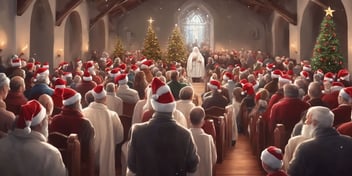- Blog
- Christmas eve
- Embracing the Sacred Tradition: Understanding the Christmas Eve Vigil

December has arrived, bringing with it the gift of anticipation and wonder. As the air grows colder and the nights longer, our hearts are filled with the familiar melodies of carols and the comforting scent of freshly baked cookies. But amidst the hustle and bustle of the holiday season, there exists a timeless tradition that offers a moment of quiet reflection and deep connection: the Christmas Eve Vigil.
Rooted in sacred customs and steeped in rich symbolism, this age-old ritual beckons us tostep away from the frenzy of materialistic celebrations and embrace the true essence of Christmas. So, let us embark on a journey to understand the spirit and significance of this cherished tradition that has for centuries kindled the innermost flame of our souls on this holiest of nights.
The Significance of Christmas Eve Vigil
- The Christmas Eve vigil holds a special significance for Christians around the world.
- It is a time for reflection, anticipation, and preparation for the birth of Jesus Christ.
- This solemn tradition allows individuals to reconnect with their faith and strengthen their spirituality.
- It serves as a reminder of the importance of the Christmas story and the hope it brings.
- The Christmas Eve vigil often involves attending Midnight Mass, lighting candles, and engaging in prayerful rituals.
- It creates a sense of unity among believers as they come together to celebrate the birth of their Savior.
- The Christmas Eve vigil provides an opportunity for individuals to pause, find peace, and remember the true meaning of Christmas.
History of the Christmas Eve Vigil
Origins of the Tradition
The origins of the Christmas Eve vigil tradition can be traced back to early Christian practices. In ancient times, believers would gather on the evening of December 24th to prepare for the celebration of Christ's birth. This vigil was a time of reflection, prayer, and anticipation. It allowed individuals to focus their minds and hearts on the true meaning of Christmas. Communities would come together to sing hymns, read scriptures, and participate in various rituals.
These ancient practices laid the foundation for the modern observance of Christmas Eve vigils, which continue to be cherished by many cultures around the world today.
Influence of Christianity
The Christmas Eve vigil holds strong ties to Christianity, shaping its rituals and significance. Through the spread of Christianity, the tradition of celebrating the birth of Jesus Christ on December 25th evolved. Many Christian denominations observe this day by attending Midnight Mass, a solemn and sacred service honoring the birth of Jesus. Additionally, the lighting of the Advent Wreath, recitation of prayers such as the Holy Rosary, and the reading of biblical passages contribute to the Christian influence on the Christmas Eve vigil. These practices establish a spiritual connection and reinforce the religious aspect of the vigil.
Rituals and Practices
Attending Midnight Mass
Attending Midnight Mass is a central part of the Christmas Eve vigil for many Christians. It is a time to celebrate the birth of Jesus Christ and rejoice in the spirit of the season. This traditional service typically takes place at or near midnight and is an opportunity for believers to come together as a community to worship, reflect, and commemorate the nativity. Midnight Mass often features a special liturgy, including hymns, scripture readings, prayers, and a sermon.
It creates a sense of unity and spiritual connection among worshippers, fostering a deep sense of faith and fellowship during this sacred time.
Lighting the Advent Wreath
During the Christmas Eve vigil, one significant ritual is the lighting of the Advent wreath. This tradition involves lighting candles on a wreath as a symbol of hope, peace, joy, and love. Each candle represents a different aspect of the anticipation for the birth of Jesus. The lighting of the Advent wreath creates a serene ambiance and fosters a reflective atmosphere. Families and communities often come together to participate in this ritual, sharing prayers, readings, or singing hymns.
It is a beautiful way to mark the progression of the Advent season and to center one's focus on the true meaning of Christmas.
Praying the Holy Rosary
"Praying the Holy Rosary" during the Christmas Eve vigil is a cherished tradition for many Catholics. It serves as a time of reflection and devotion, allowing individuals to connect with the spiritual significance of the holiday. The repetitive prayers recited on each bead of the rosary beads create a calming and meditative atmosphere. It can be a personal and communal experience, bringing families and friends together to join in prayer.
By engaging in this practice, individuals deepen their connection to the Christmas story and find peace amidst the busyness of the season.
Cultural Variations of the Christmas Eve Vigil
Latin American Traditions
Latin American traditions surrounding the Christmas Eve vigil are rich in cultural significance. One popular tradition is "Las Posadas," where individuals reenact Mary and Joseph's search for a place to stay. Taking part in novenas, nine consecutive days of prayer, is also common. These traditions foster community bonds and emphasize the spiritual aspect of the Christmas season.
Whether it's the processions, the communal meals, or the vibrant displays of nativity scenes, Latin American Christmas Eve vigils create a sense of unity and devotion among participants. These practices offer a unique and meaningful way to embrace the spiritual significance of this holy night.
Las Posadas
Las Posadas is a Latin American Christmas Eve vigil tradition that reenacts Mary and Joseph's search for lodging before the birth of Jesus. It is a lively and vibrant procession that typically takes place in neighborhoods or communities. Some key points about Las Posadas include:
- Participants divide themselves into two groups, representing Mary and Joseph, and go from house to house seeking shelter.
- The procession is accompanied by traditional songs and prayers, and often culminates in a designated home where a nativity scene is set up.
- The host family welcomes the participants with food and refreshments, fostering community spirit and hospitality.
- Las Posadas not only commemorates the journey of Mary and Joseph but also serves as a reminder of the significance of compassion, inclusivity, and the importance of coming together as a community.
- This tradition creates a sense of unity and provides an opportunity for people to reflect on the true meaning of Christmas while fostering cultural identity and togetherness.
Novenas
Novenas are a significant part of the Christmas Eve vigil in many Latin American countries. These are nine-day prayer rituals leading up to Christmas, where families and communities gather to honor the birth of Jesus. Each day, a specific prayer is recited, fostering a sense of anticipation and reflection. Novenas provide an opportunity for people to deepen their faith and come together in prayer during this sacred time.
Families may light candles, sing hymns, and share traditional meals as they engage in this spiritual practice. Novenas help create a sense of unity and devotion among participants as they prepare their hearts for the joyous celebration of Christmas.
European Traditions
European traditions associated with the Christmas Eve vigil hold diverse cultural significance. One such tradition is the burning of the Yule log, a symbol of warmth and protection. Families gather around the fire, sharing stories and singing carols. In Scandinavian countries, Saint Lucia's Day is celebrated on December 13th, honoring the Christian martyr by choosing a young girl to wear a crown of candles and lead a procession.
These European customs showcase the importance of community, storytelling, and the symbolism of light during the Christmas Eve vigil. Embracing these traditions can foster a sense of connection and bring added meaning to the holiday season.
Burning the Yule Log
The tradition of burning the Yule Log during a Christmas Eve vigil dates back to ancient European customs. In this ritual, a large log is chosen, traditionally from an oak tree, and lit in the fireplace with prayers and blessings. As the log burns, it symbolizes warmth, light, and the hope of new beginnings. The ashes from the Yule Log are believed to bring good luck and protect against evil spirits.
Today, many families continue this tradition by gathering around the fireplace, sharing stories, and enjoying the cozy ambiance created by the crackling fire. It is a cherished moment that brings families together and fosters a sense of unity and celebration during the Christmas season.
Saint Lucia's Day
Saint Lucia's Day is a popular tradition observed during the Christmas Eve vigil in European countries like Sweden, Norway, and Denmark. It is a celebration of the Christian martyr Saint Lucia, who is believed to bring light and hope during the darkest time of the year. On this day, a young girl is chosen to portray Saint Lucia, wearing a white gown and a crown of candles. She leads a procession of people singing traditional songs, symbolizing the triumph of light over darkness.
Saint Lucia's Day is a beautiful example of how the Christmas Eve vigil is enriched with cultural customs and brings communities together.
Modern Interpretations
Community Christmas Eve Vigils
Community Christmas Eve Vigils foster a sense of togetherness and shared spirituality. These gatherings enable people to come together and celebrate the holiday season in a meaningful way. Here are some insights into the practice:
- Community Christmas Eve Vigils provide an opportunity for neighbors and friends to gather in local churches or public spaces to commemorate the birth of Jesus Christ.
- Participants engage in prayer, hymns, and readings that reflect the sacred significance of Christmas.
- Through shared rituals and traditions, these vigils create a sense of unity and belonging within the community.
- They also offer a chance for individuals to connect with others who share similar beliefs and values.
- In some cases, community Christmas Eve Vigils extend beyond religious boundaries and welcome people of diverse backgrounds, promoting inclusivity and understanding.
By participating in Community Christmas Eve Vigils, individuals can deepen their appreciation for the holiday season and strengthen their bond with their local community.
Virtual Christmas Eve Vigils
Virtual Christmas Eve Vigils have gained popularity in recent years, offering a unique way to connect and participate in the sacred tradition from the comfort of our own homes. Through live-streamed services or video conference calls, individuals and families can join in prayers, carols, and candle-lighting ceremonies with their loved ones near and far.
This digital approach provides an opportunity for those unable to attend physical vigils or separated by distance to still experience the senseof community and spiritual connection. Many churches and religious organizations now offer online platforms and resources to facilitate these virtual gatherings, ensuring that the Christmas Eve vigil can be enjoyed and cherished by all, regardless of physical proximity.
Key takeaways
The Christmas Eve Vigil is a holy tradition observed by many Christians around the world. During this sacred time, believers come together on the night before Christmas to celebrate the birth of Jesus Christ. The vigil typically includes prayers, readings from the Bible, and joyful hymns that create a reverent and joyous atmosphere. It is a time for reflection, gratitude, and deepening one's connection with their faith.
The Christmas Eve Vigil offers a unique opportunity to embrace the spiritual significance of Christmas and partake in centuries-old rituals that have been passed down through generations. It serves as a reminder of the true meaning of the holiday season and allows individuals to experience the wonder and beauty of God's love. By participating in this tradition, people can foster a sense of unity and community within their religious community, while also strengthening their own personal relationship with God.
Read On

The Beauty and Tradition of Christmas Eve Midnight Mass
As the streets grow quiet and the world settles into a peaceful slumber, there is a mystical...

What is the history and importance of the Christmas Eve midnight church service?
As the clock strikes midnight on Christmas Eve, churches around the world come alive with a...

Experience the Magic of Christmas Eve Mass – Traditions and Meaning
As winter approaches, the air becomes crisp and lights twinkle in the distance, signaling the...